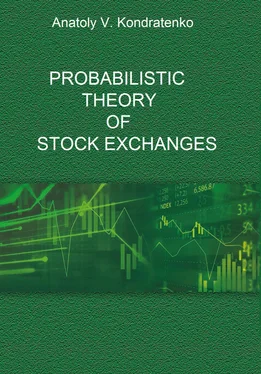It is our deep conviction that human nature, as well as the nature of market economic systems, is such that all our knowledge of markets is only approximate, so all market decisions can only be approximately correct and optimal. Moreover, in practice we are Explicitly or implicitly aware of this fact and take it into account in our decision-making and evaluation of its consequences. Strictly speaking, our market decisions can only be probabilistic in nature. And since, according to our view of the market economy, all economic processes and phenomena are exclusively the result of the actions of all the economic agents, it inevitably follows from all of the above that all economic processes and phenomena in the market economy are also, to some extent, probabilistic in nature. Consequently, only one step remains to draw the fundamental conclusion that the market economy is not just a complex, dynamic, nonequilibrium system, but also a probabilistic one [von Neumann and Morgenstern, 1970; Kondratenko, 2005, 2015; Mises, 2005; Waltuch, 2008; Keynes, 1921; Farjoun, Machover, 1983; Ball, 2003]. Therefore, in order to present a sufficiently complete description of such complex probabilistic systems, the corresponding economic theory should also be largely probabilistic. For this, at least, it is necessary to incorporate the concept of uncertainty and probability into economic theory at a suitable mathematical level, i.e., to develop a dynamic probabilistic economic theory that is sufficiently adequate to economic reality. Our research is devoted mainly to achieving this goal.
In this paper, we further describe the basic mechanisms of supply and demand formation, as well as the mechanisms of price formation, trade volume formation, and equilibrium setting in markets. The emphasis is on a detailed description of the nature of these fundamental market concepts and definitions in the standard general scientific language of physics and mathematics, which will allow us to critically re-evaluate these concepts and definitions within the framework of probabilistic economics.
The main paradigm of probabilistic economics for us is the following statement already formulated above. All markets consist of people – buyers of some goods and simultaneously sellers of these goods. Everything the market does is done by these people, and it is the actions of all these people in the market that determine all the market results [Mises, 2005]. A similar claim was once made by Richard Feynman et al. [1978] regarding physical multiatomic systems. It is this circumstance that allows us to establish an analogy between multi-agent market economic systems and multiatom physical systems and to bring physical approaches and language into economic theory. Based on this main paradigm and with careful consideration of all the basic features of human activity, explored in detail by Mises [2005], we will define the following six principles of probabilistic economics, which are essentially general postulates:
Principe 1. Supply and demand principle;
Principe 2.Agent principle;
Principe 3.Institutional and environmental principle;
Principe 4.Dynamic and evolutionary principle;
Principe 5.Trade volume maximization principle;
Principe 6.Uncertainty and probability principle.
The demand and supply principle reflects the fact that almost all important effects and processes in the market are determined by the interaction of supply and demand in the market. The agent principle testifies to the unique driving role of interacting market agents and the significant contribution to this interaction of social cooperation between them in the modern market economy. The institutional and environmental principle expresses the fact that the interaction of agents with different social institutions, different stakeholders and the external natural environment should be taken into account together with the interaction between the agents. The dynamic and evolutionary principle reflects the fact that market behavior is to some extent deterministic in nature and therefore, generally, can be analyzed by means of some equations of motion that describe both stationary behavior and the evolution of markets. The trade volume maximization principle determines the direction of the generally fairly free market under the influence of market forces. The uncertainty and probability principle shows that all market processes and phenomena, including decision-making, are probabilistic in nature and thus help us to understand what mathematical apparatus we need to adequately describe the behavior of agents and the market as a whole in the circumstances of uncertainty.
In essence, these principles define the main acting forces in the market and the main features of the market structure, so when performing specific studies of markets in our physico-economic models, they should all be taken into account, if possible, simultaneously, since they all represent market effects of the same significance in terms of influence on the final result of market operation, namely on the price structure and trade volumes in the market at each moment. If, for example, a certain economic study does not take into account the influence of the state, it cannot claim to be an adequate description of the modern economic world in which the role of the state is paramount: the state can both accelerate and suppress economic activity of other market agents. And the role of the state in the modern economy is twofold: it can both set important rules and introduce new institutions, thereby influencing the strategies of market agents, and be an active and strong market agent itself.
We emphasize that in these principles, if we consider them one by one, we can almost always find their «roots» in separate works of the previously cited authors of classical economic theory: Adam Smith (theory of commodity exchange, etc.), Carl Menger (theory of subjective value, etc.) and Ludwig von Mises (principle of methodological individualism, concept of market process, dynamic interpretation of S&D law, etc.). Here they are brought together, formulated quite clearly and it is emphasized that they should be taken into account simultaneously in the development of any economic theory, claiming for an adequate description of the real economic world, in which living people, rather than fictional characters like homo economicus in imaginary markets with perfect competition and with a supposedly all-powerful market hand, formed only by agents representing people and business without regard to the role of the state. What is brand new here, are the dynamic and evolutionary principle with the idea of finding equations of motion for market agents, the trade volume maximization principle to establish trends in the movement of market prices and the uncertainty and probability principle with the idea of using probabilistic strategies that the agents use to put their quotations and, most importantly, the elaborated mathematical apparatus, which allows for extensive quantitative research of real economic systems, including organized markets.
1.2. DIRECT AND INVERSE PROBLEMS OF ECONOMIC THEORY
To develop a probabilistic theory of the exchange, a physical method of economic research was used, the essence of which consists in using standard theoretical approaches of physics for modeling and calculating economic systems, with subsequent constant comparison of calculation results with experimental data to verify the used approaches, models and theory as a whole and for the purpose of establishing thereby the applicability limits of models and theory as a whole in those cases where their improvement and development is feasible. If the results of calculations contradict the experiment to a sufficient degree, the theory should be rejected without hesitation, and the process of theory creation should be started anew. For the sake of certainty and clarification of the theoretical problems studied in this book, we further call this option of the physical method application “a solution of the direct problem of the economic theory”, in which the results of economic activity (in this book, stock trading) are calculated based on some initial principles ( ab initio principales ), which are then compared with the corresponding experimental data (in our case – with the results of stock trading). We oppose this approach to solving, shall we say, the inverse problem of economic theory, in which by mathematical processing of experimental data one seeks to obtain information about the studied economic system. It should be said that we borrowed the terms "direct and inverse problem" from the theory of elementary particles scattering, which solves formally similar problems. It is known that solving the inverse problem in physics is very difficult and there is no reason to think that solving the inverse problem in economics will be easier. Here we reserve to developing the methods for solving the direct problem of economics as applied to stock exchanges, so all conclusions and discussions in this book refer only to the direct problem of economic theory, unless specifically stated. In order to avoid misunderstandings, we will repeatedly emphasize this aspect of this study.
Читать дальше












